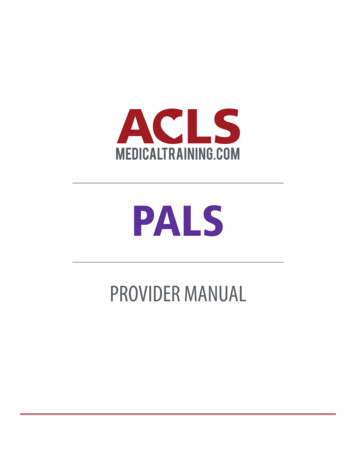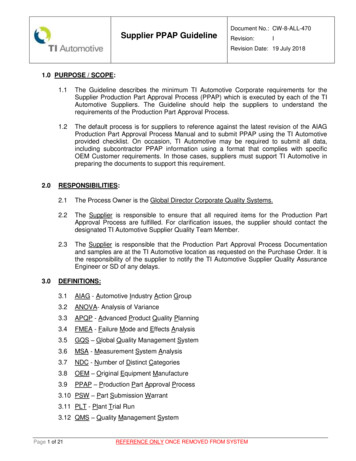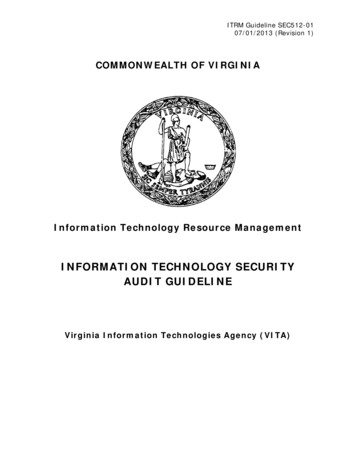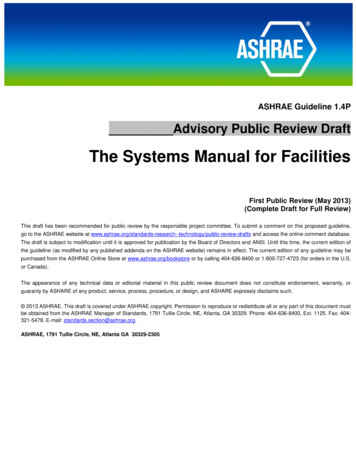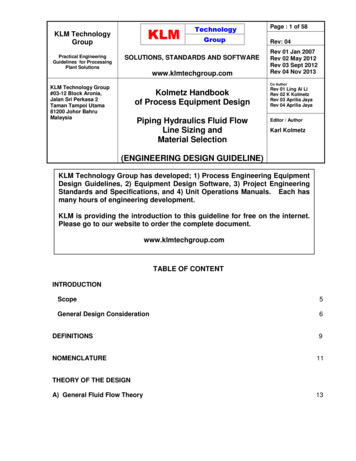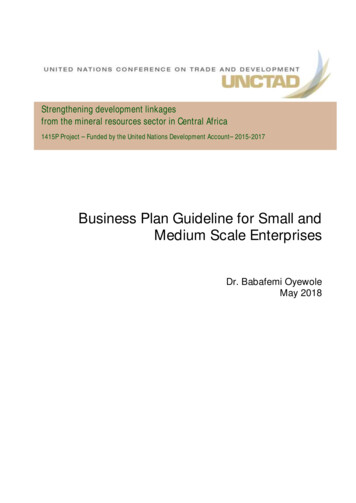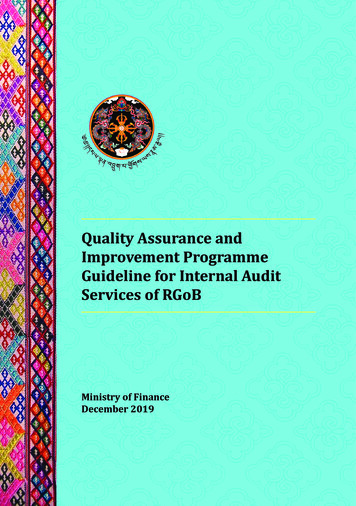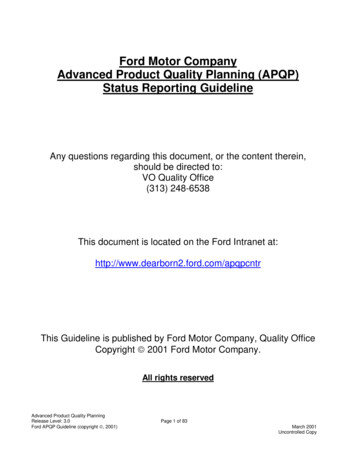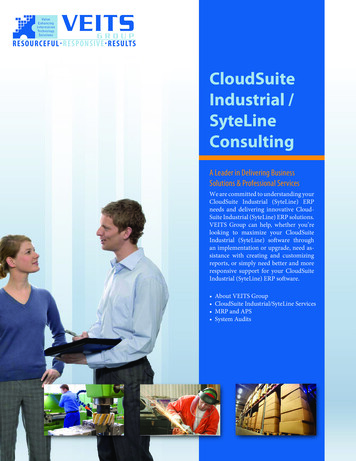
Transcription
Industrial technologyand design guidelineA practical handbook for ITD staff
Table of contentsPart 11.DEPARTMENTAL MANAGEMENT AND SAFE PRACTICE6 1.1 General introductiono1.1.1 Subject guidelines – Qld Curriculum and Assessment Authority (QCAA)o1.1.2 Considering safety in ITD activities667 1.2 Management of safetyo 1.2.1 Responsibility for the management of safetyo 1.2.2 Legislation and regulatory requirementso 1.2.3 First aid facilitieso 1.2.4 Notification of accidents, injuries and incidents1.3 Health, safety and the lawo 1.3.1 Statute law and common lawo 1.3.2 Legal indemnityo 1.3.3 What is ‘reasonably practicable’ ?o 1.3.4 Workplace health and safety school inspectorso 1.3.5 School-based health and safety advisors (HAS and HSRs)8891011121213131415 1.4 Qualifications and requirements for ITD teachers and staffo 1.4.1 Classroom teacherso 1.4.2 Vocational Education and Training (VET)o 1.4.3 Conditions of employment for substitute ITD teacherso 1.4.4 ITD teacher aide qualifications and responsibilities1616171818 1.5 Student induction to workplace safety and trainingo 1.5.1 Introduction To Workplace Safety – A Student Handbooko 1.5.2 Student “Safety Induction” Registero 1.5.3 A message to parents and student safety contracts212122242.RISK MANAGEMENT28 2.1 Risk management guidelineso 2.1.1 Risk management overviewo 2.1.2 Risk management code of practice glossary of key words in risk managemento 2.1.3 The four step risk management processo 2.1.4 Hierarchy of risk controlo 2.1.5 ITD hazard identification Checklist for identifying hazards in ITDo 2.1.6 Manual handling and ergonomics282830303133353538 2.2 Risk assessment guidelineso 2.2.1 Curriculum activity risk assessment (CARA)o 2.2.2 ITD activity information sheets – CARA support attachmentso 2.2.3 Plant and equipment risk assessmento 2.2.4 Chemicals and hazardous materials risk assessmento 2.2.5 Annual safety assessment393940414244 2.3 “Risk Management” Professional Development45 o2.3.1 Managing risks in ITD workshops program2Reviewed August 2018 V3Uncontrolled when printed.Department of EducationOrganisational Safety and Wellbeing45
Part 23.MAINTAINING A PRACTICAL WORKSPACE ENVIRONMENT46 3.1 Establishing a culture of safety46 3.2 Class size limits48 3.3 Workspace layouto 3.3.1 Workplace planning and machinery placement Safe work zoneso 3.3.2 Project storage50505151 3.4 Workspace conditionso 3.4.1 Ventilation systemso 3.4.2 Environmental dust and dust extraction Risks and control measures: dustso 3.4.3 Industrial noise Risks and Control Measures: noiseo 3.4.4 Flooringo 3.4.5 Lighting5253535355555657 3.5 Safety signageo 3.5.1 Classifications and usageo 3.5.2 Workplace safety colour codes585860 3.6 Electrical safetyo 3.6.1 Regulatory electrical requirements for ITD workspaceso 3.6.2 Testing and taggingo 3.6.3 Safety switching and electrical isolation deviceso 3.6.4 Lockout of machinery, plant and equipment6161626264 3.7 Fire safetyo 3.7.1 General precautions for ITD departmentso 3.7.2 Fire extinguishers – Types and uses6565664.PERSONAL PROTECTIVE EQUIPMENT68 4.1 Guidelines for the selection of PPE68 4.2 Selection of PPEo 4.2.1 Foot protectiono 4.2.2 Eye and face protection Hair protectiono 4.2.3 Hearing protectiono 4.2.4 Hand protectiono 4.2.5 Respiratory protectiono 4.2.6 Clothing (body) protectiono 4.2.7 Welding protection6969717272747576775.MACHINERY, PLANT AND EQUIPMENT79 5.1 Purchasing of ITD machinery, plant and equipmento 5.1.1 Procurement delegationo 5.1.2 DoE standing offer arrangements (SOAs)o 5.1.3 Purchasing outside a DoE standing offer arrangement (SOA)o 5.1.4 Asset disposals and write-offs80808182833Reviewed August 2018 V3Uncontrolled when printed.Department of EducationOrganisational Safety and Wellbeing
5.2 Responsibility for safe use of machineryo 5.2.1 Schools responsibilityo 5.2.2 Teachers responsibilityo 5.2.3 Working safely with machinery, plant and equipment85858687 5.3 Student use of machinery, plant and equipmento 5.3.1 Student usage control index9091 5.4 Service maintenance and responsibilities94 5.5 Equipment maintenance records (EMRs)95 5.6 Safe operating procedures (SOPs)96 5.7 Battery powered tools and equipment97 5.8 Hand tools98 5.9 Compressed air, pneumatics tools and equipmento 5.9.1 Safe use of nailing tools (nail guns) in schools99100 5.10 Welding processes and equipmento 5.10.1 Oxy/acetylene – fuel gas welding, cutting and brazingo 5.10.2 Electric arc welding – MMAW, MIG, TIG and plasma cutting102102103Part 36.CHEMICALS AND HAZARDOUS SUBSTANCES105 6.1 Legislative requirements for chemicals in schools105 6.2 Management of chemicals and hazardous materialso 6.2.1 Safety data sheets (SDS)o 6.2.2 ChemWatch – chemical management system and SDS databaseo 6.2.3 Ordering and purchasing of chemicalso 6.2.4 Transportation and storage of chemicalso 6.2.5 Hazardous chemicals manifest and registero 6.2.6 Decanting and re-labelling of chemicalso 6.2.7 Disposal of chemicals and hazardous materialso 6.2.8 Chemicals presenting an uncertain or unpredictable risko 6.2.9 Managing risks with chemicals and hazardous materialso 6.2.10 ITD chemicals and hazardous materials for particular consideration105106107108109110110111112113114 6.3 Wood Dust and Toxic Timberso 6.3.1 Health concerns and symptomso 6.3.2 Toxic timber species and your health Toxic timbers indexo 6.3.3 Permissible exposure limits (PEL) for wood dusto 6.3.4 CCA treated timbero 6.3.5 Formaldehyde adhesives in MDF and plywoodo 6.3.6 Managing the risks and control measures1171171181191251261261277.APPENDICES128 7.1 ITD activity information sheets1284Reviewed August 2018 V3Uncontrolled when printed.Department of EducationOrganisational Safety and Wellbeing
Disclaimer:This document is developed and distributed on this website by the State of Queensland for use by Queensland state schools.Use or adaptation of, or reliance on, this document or information in this document by persons or organisations other than the Stateof Queensland is at their sole risk. All users who use, adapt or rely on this document or any information in this document areresponsible for ensuring by independent verification its accuracy, currency and appropriateness to their particular circumstances.The State of Queensland makes no representations, either express or implied, as to the suitability of this document or theinformation in this document to a user’s particular circumstances.To the full extent permitted by law, the State of Queensland disclaims all responsibility and liability (including without limitation,liability in negligence) for all expenses, losses, damages and costs arising from the use or adaptation of, or reliance on, thisdocument or any information in this document.Links in this document to external websites are for convenience only and the State of Queensland has not independently verifiedthe information on the linked websites. It is the responsibility of users to make their own decisions about the accuracy, currency,reliability and correctness of the information at these external websites.5Reviewed August 2018 V3Uncontrolled when printed.Department of EducationOrganisational Safety and Wellbeing
1. Departmental managementand safe practice1.1 General introductionThis Guideline document on managing safety in Industrial Technology and Design (ITD) for QueenslandState School secondary departments complies with all current state legislation and regulations including thenational Work Health and Safety Act 2011 (Qld). It is designed to be a source of easy reference andprovides important information relating to the establishment, management and maintenance of a healthyand safe teaching, learning, and working environment for ITD staff and students.ITD staff should find support for the due diligence required to ensure the safety of students through currentlegislative requirements and their departmental accountabilities. All teachers should appreciate that it isimposed upon them to take reasonable precautions at all times and to ensure that they have up-to-dateknowledge of all health and safety risks involved in their ITD activities, thus avoiding foreseeable dangersto themselves and the students placed in their care.All Information and guidelines offered are directed not only at ITD Heads of Department, SubjectCoordinators and teachers, but also to others who work within your ITD department, including ITD teacheraids, Special Needs teaching assistants, other support staff and trainees.1.1.1 Subject Guidelines – Queensland Curriculum and Assessment Authority(QCAA)The term – Industrial Technology and Design (previously Manual Arts) generally refers to the secondaryschool faculty area reasonable for the delivery of the following range of related subjects:Lower Secondary – Years 7 10Design and Technology (QCAA Syllabus and the Lower Secondary Subject Area Guidelines – refer below)The Lower Secondary curriculum can be somewhat innovative. For Years 7 - 8 & 9, ITD studies shouldincorporate the “Technology Essential Learning’s” syllabus requirements of an interactive, cyclical andrecursive design process involving elements of investigation, ideation, production and evaluation whenstudents design and create their class projects, individual artefacts or prototype models. Schools are alsorequired to implement the Australian Curriculum (ACARA) learning areas of Digital Technologies andDesign & Technologies.Year 10 QCAA syllabus guidelines will provide schools with information and advice for the planning anddelivery of challenging and engaging courses, specifically for students in Year 10.Senior Secondary – Years 11 and 12The QCAA supports several subject syllabuses specifically for Years 11 and 12 in the area of ICT andDesign (Information Communication Technologies and Design). All may count as credits towards a studentbeing awarded the Queensland Certificate of Education (QCE).QCAA is redeveloping and revising senior syllabuses to support the introduction of Queensland’s new senior assessmentand tertiary entrance systems from 2019.6Reviewed August 2018 V3Uncontrolled when printed.Department of EducationOrganisational Safety and Wellbeing
Students will be required to select from the following: Aerospace SystemsEngineeringDesignSenior Syllabuses subjectsoooooGeneral subjectGeneral subjectGeneral subjectApplied subjectsBuilding and Construction SkillsFurnishing SkillsEngineering SkillsIndustrial Technology SkillsIndustrial Graphics SkillsAdditionally, schools may continue to offer VET certificates and competencies separate to these QCAAsyllabuses. Vocational Education and Training programs (VET)Note: refer to these QCAA web links for further details on ITD subject area guidelines: QCAA– Years 8 to 10 Design & Technology Subject Area Guidelines1.1.2 Considering Safety in ITD ActivitiesCurriculum planning processes for ITD activities should embrace the consideration of students’ learningneeds delivered in a practical and safe learning environment; an environment in which the hazardsinevitably associated with practical workshop activities are reduced to an acceptable level. ‘Good practice’workplace safety considerations that include diligent risk management procedures and appropriate riskassessment strategies will hopefully become a default part of any ITD departmental activity planning andcurriculum review process.Because complex practical working environments change over time, department guidelines and safetyadvice for ITD will be regularly reviewed and underwritten, to ensure that one’s diligent duty of care isconsistently maintained.This ITD Guideline aims to encourage a comprehensive departmental “Culture of Safety” within an ITDfaculty – creating an atmosphere in the workplace conducive to developing appropriate “work safe”attitudes.In addition, it is imperative that all ITD teachers model, to their students, the sound principles of WorkplaceHealth and Safety (WHS) explicitly, including a mature and responsible attitude to safe working practices,theoretical knowledge, and technical skill levels relevant to all areas of Industrial Technology and Design.The principles that students learn at school should form the basis of common workplace safety applicableto their future employment. A culture of workplace safety is, therefore, an integral consideration for allplanned ITD activity.As an ITD staff resource, this publication will not provide all the answers to all ITD health and safety issuesor concerns. Further detailed information, i.e. department policy and procedures clarification is alwaysavailable online and many useful web-links are provided here for staff access:Regular reference should be made to the Policy and Procedure Register and other essential departmentonline sources, particularly our Organisational Safety and Wellbeing webpage: Creating Healthier Workplaces (CHW)Finally, all EQ State Schools are encouraged to note the contact details for their Regional WorkplaceHealth and Safety Consultant. Regional Senior Health and Safety Consultants7Reviewed August 2018 V3Uncontrolled when printed.Department of EducationOrganisational Safety and Wellbeing
1.2Management of SafetyThe Queensland Department of Education (DoE) acknowledges that an effective and productive IndustrialTechnology and Design curriculum involves a significant amount of high risk practical workshop curriculumactivity. Such experiences provide opportunities to introduce students to the concept of risk managementand safe work practices. Naturally, it is essential that all ITD staff are fully conversant with the managementof safety in their workplace and that they carefully plan curriculum activities.1.2.1 Responsibility for the management of safetyEvery person within a school has a responsibility and legal duty to be actively involved in the effectivemanagement of safety. Responsibilities focus on planning the curriculum, providing meaningful educationalactivities with appropriate supervision and working cooperatively for a safer environment or workspace.An appropriate level of supervision when teaching ITD will depend on the range of equipment utilised, thenumber of students involved, their maturity and individual needs and the physical nature of the particularworkplace. Minimum standards have been established for ITD supervision. Refer to the Curriculum ActivityRisk Assessment Guidelines within this document.Do not forget to consult with all ITD staff, Principals, Special Needs teaching assistants, ITD teacher aids,trainees and any voluntary staff when formulating the departmental safety management strategies. Ensurethat adequate procedures be developed, implemented, managed and scrutinised meticulously to ensurethat those responsible: can safely deliver any High or Extreme risk ITD curriculum activities with evidence of anappropriately prepared Curriculum Activity Risk Assessmentregularly undertake curriculum activity risk assessments and enforce them rigorouslyhold specialist ITD teaching qualifications, and receive adequate health and safety training andregular ITD Professional Development training – only suitably qualified staff should be usingdesignated restricted machinery or processeseffectively communicate information, policy and procedures to those who need to know –ensuringall workshop users are aware of the various hazards and understand the procedures to control theassessed risksensure all powered machinery, plant and equipment is regularly inspected electrically, tested andtagged as required and maintained to recognised standards and that good records are kept – alldefective equipment is reported and ensure electrical safety is never compromisedensure all non-powered machinery, plant and equipment is also regularly inspected and maintainedas required to the manufacturers standards and that good records are keptwork in a positive environment and participate in consultation on all WHS issuesensure all Safety Data Sheet (SDS) information is up-to-date, available and followedimmediately address issues relating to excessive dust, industrial noise, safety signage, etc.provide adequate space allocation for fixed machines, benches and tools, project storage andoverall comfortable working arrangements;ensure a safe educational environment and provide diligent duty of care and appropriate levels ofsupervision during teaching and learning activitiesensure special-needs groups are considered in regard to all WHS issuesensure the numbers of students working in any particular ITD area contribute to a safe workingenvironment and do not present an unacceptable risk to health and safetyprovide and maintain adequate first aid facilities and provide for effective emergency managementand reporting of all accidents and injuriestake reasonable care of their own health and safety and that of colleagues and studentsdo not interfere with, or misuse, resources provided for health, safety and welfare purposes, and docomply with our Work Health and Safety Act 2011 (Qld).8Reviewed August 2018 V3Uncontrolled when printed.Department of EducationOrganisational Safety and Wellbeing
1.2.2 Legislation and regulatory requirementsFor the purposes of this ITD guidelines handbook for teachers, the following list of government legislation,regulations, policies, procedures and codes of practice requirements are all important sources of reference.1. Education (General Provisions) Act 2006 (Qld)“An Act about the education of children and the participation of young people in education and training, andfor other purposes.”2. Policies and Procedures Register (PPR)Policies and Procedures Register is a centralised location for all departmental and corporate policies,procedures, guidelines and other administrative instructions and directives. Policies outline what the department intends to do through stated plans of action. A procedure is a step-by-step process that should be followed to achieve an outcome or result forthe department, or on behalf of the Australian or Queensland Governments, in response tolegislation, directives, standards or policy.To help locate a particular procedure in this register, select the relevant category on the orange toolbar oruse the search tool located at the top right of the screen. You will find navigational links to six listedprocedural categories. Those of particular relevance to ITD might include the following: ‘School Education’ and ‘Corporate’ ’School Education’ ProceduresThe “School Education” category within the register provides guidance in relation to the operationalfunctions of schools, as well as the services and programs they offer.The Sub-category ‘School Management’ includes ‘Managing Risks in School Community Activities’. Thisprocedure specifically outlines the responsibility regional directors, principals, teachers and others have inmanaging the hazards and risks associated with all school curriculum activities.The Curriculum Activity Risk Assessment Guidelines describe the scope of specific curriculum activities,sets minimum standards for supervision and qualifications, suggested risk control measures and guidesstaff through the written “Risk Assessment” process. This written assessment is necessary to help identify,minimise and record any inherent High or Extreme risks and subsequent control measures before thecommencement of any proposed ITD curriculum activity. Workplace Health, Safety and Wellbeing proceduresThe “Corporate – Human Resource Management” category within the register, and more specifically the“Workplace Health, Safety and Wellbeing” procedures provide guidance to implement practices whichprovide safe, supportive and healthy working and learning environments for department employees andother persons involved in department activities: e.g. First Aid, Managing Risks with Chemicals, WHSOfficers, Incident notification.3. Work Health and Safety Act 2011 (Qld)Schools are workplaces and, as such, operate under the Work Health and Safety Act 2011 (Qld). Newnational legislation sets out legal rules that govern school workplaces to ensure the health, safety andeffective welfare management of employees. The Act defines those with an obligation to ensure safety.Note: for this legislation, the term ‘The Act’ is defined to include the regulations unless a particularprovision provides otherwise.9Reviewed August 2018 V3Uncontrolled when printed.Department of EducationOrganisational Safety and Wellbeing
4. Work Health and Safety Regulation 2011 (Qld) The Work Health and Safety Regulation reflects the national model with some changes which willenable it to operate effectively in Queensland.5. WHSQ – How to Manage WHS Risks, Code of Practice 2011This Code of Practice applies to anyone who has a duty of care in the workplace. Health and safetyobligations require duty holders (ITD teachers and administration, or ‘workers’) to consider all risksassociated with work, not only those for which regulations and codes of practice exist. This Code operatesunder the national Work Health and Safety Act 2011 (Qld) and the Electrical Safety Act 2002, to make sureall hazards in the workplace are eliminated or, at least, minimised to acceptably safe levels.6.Electrical Safety Act 2002 (Qld)The Act imposing obligations on all persons who may affect the electrical safety of others by their actionsand establishes regulatory electrical safety benchmarks for industry and the community, including schools.7.Australian Standards: AS/NZS, 4801: 2001 – OHS Management Systems“. organisations (including schools) must develop and implement control actions which, wherever possible,eliminate hazards or isolate people from the hazard. Where this is not possible, work activities should beplanned or controlled through administrative means to the extent necessary to prevent injury and illness.”Note: for more information, or if further guidance is required on Health and Safety Legislation andregulatory Codes of Practice for department workplaces, refer to the following useful link: WHSQ– Codes of Practice Index1.2.3 First aid facilitiesIn compliance with the Work Health and Safety Act 2011 (Qld), all schools should ensure the health andsafety of staff, students and “others”. This statutory obligation requires Education Queensland to provideand maintain adequate first aid facilities in schools for the effective emergency management of accidentsand injuries, based on an evaluation of risks and need.Due to the many hazards and risks associated with the diversity of machinery, tools, materials andchemical substances used daily in ITD workshops, any injuries sustained have the potential to be moresevere than might result in other subject areas in schools. ITD staff, therefore, should always be alert toquickly recognise reasonably foreseeable hazards and appreciate the levels of risk associated with them.It is important therefore, that managed emergency first aid procedures be established to ensure thatappropriate medical attention can be delivered in a timely manner. It is also recommended that the ITDdepartment assist the school administration to identify and recommend all first aid equipment, placement offacilities and any professional staff training required.Helpful MyHR W HS Staff Training Support Tutorials are available online: OnePortal– MyHR Student First AidThe best way to be prepared for responding to injuries, accidents and emergency situations in ITD is tokeep an appropriate, well stocked, First Aid Kit on hand – visible and accessible.First aid kits should be wall mounted, dust proof, well signed, and contain an appropriate variety ofdressings and bandages depending upon the environment in which they are to be used. The QueenslandAmbulance Service has a number of different first aid kits available for use in environments ranging fromthe home, to schools and industrial work sites. QueenslandAmbulance Service – First Aid Kit Fact Sheet10Reviewed August 2018 V3Uncontrolled when printed.Department of EducationOrganisational Safety and Wellbeing
The Queensland Ambulance Service also has a very useful website. Staff can access numerous health andsafety publications, details on first aid training courses available to teachers and several downloadableresources including some important emergency first aid and First Aid Training Courses.Note: For more information, or further guidance on requirements for First Aid facilities and Staff training inQueensland schools, refer to the following useful links: Policyand Procedure Register (PPR) – First Aid Creating WHSQHealthier Workplaces (CHW) – First Aid– First Aid in the Workplace Code of Practice 2014 RegionalHealth and Safety ConsultantsFurther Useful Resources: AnaphylaxisManagement QueenslandAmbulance Service – fact sheets1.2.4 Notification of accidents, injuries and incidentsThe notification of accidents, injuries and health and safety incidents is also an important component inthe management of health and safety in schools. The department has policies and procedures, inaccordance with current legislation, that detail the requirements for the recording, notification andmanagement of accidents and incidents in all department workplaces. The following link providesinformation on this procedure: PPR– Health, Safety and Wellbeing Incident ManagementThe department has also prepared for staff an “Incident Recording and Notification Guideline” providinginformation on the correct notification systems to be used, explanatory flowcharts and definitions.MyHR WHS staff training material, including helpful online tutorials is also available: OnePortal– MyHR WHS Training and Support MaterialThe MyHR WHS SolutionAll EQ Schools and Regional Offices that have access to the MyHR WHS Solution (MyHR WHS) are torecord all health and safety incidents in MyHR WHS. If a “Notifiable” incident occurs then Workplace Healthand Safety Queensland (WHSQ) must be notified immediately (refer below).Note: If MyHR WHS is not available, e.g. system outage, school camp, excursion, staff withlimited online access, then complete the paper-based Health and Safety Incident DataCollection Form.Notifiable Incidents: For example, if a staff member or student sustained a significant, seriousinjury or illness whilst working in an ITD workspace, e.g. amputation, head injury, spinal injury, anelectric shock, etc., then this incident is to be notified, by the school administration, directly toWHSQ immediately of the occurrence. It is recommended that workplaces notify WHSQ by phoneon 1300 362 128 and then record the incident in MyHR WHS.If notification is not made of a serious event in a department workplace, a WHSQ Inspector can issue anInfringement Notice for a breach of the legislation.It is very important that all reported accidents and injuries be investigated by staff, irrespective of theirdegree of severity. Immediate interim safety control measures may need to be taken to help prevent any11Reviewed August 2018 V3Uncontrolled when printed.Department of EducationOrganisational Safety and Wellbeing
similar recurrence. The current, proved Curriculum Activity Risk Assessment (CARA) or, perhaps, aparticular Plant and Equipment Risk Assessment report may also need to be re- evaluated, modified andre-approved if necessary.Note: for more information or guidance on requirements for notification of accidents and incidents inQueensland schools, refer to the following useful links:– Health, Safety and Wellbeing Incident Management PPRFurther useful resources DoE– Management of Safety in Design and Technology – checklist WHSQ– Managing Risks of Plant in the Workplace – Code of Practice 20131.3 Health, safety and the lawWe are all expected to know the law. In a court of law, ignorance is not accepted as an excuse. WorkplaceHealth and Safety legislation has gained an increasing profile. Trends in other parts of the world haveresulted in an increase in litigation for negligence which is also evidenced in Australia. Obviously, it isuncommon for any one person to know and understand all of the law but it is important for teachers to havea basic understanding.1.3.1 Statute law and common lawThe various Acts and Regulations in relation to an ITD workplace are known as Statute Law. Such lawsenforce rules and regulations imposed as an Act of Parliament. An example of such a law, and one that weall should abide by is the new “harmonised” National WHS Act, known as the Work Health and Safety Act2011 (Qld). The main aim of this national Health and Safety Act is to ensure that employers and employeescan work together to help ensure we remain free from unacceptable risk of illness or injury created byworkplaces and workplace activities. WorkHealth and Safety Act 2011 (Qld) WorkHealth and Safety Regulation 2011 (Qld) WHSQ– Managing Risks of Plant in the Workplace – Code of Practice 2013 WHSQ– Codes of Practice IndexCommon Law establishes our diligent duty of care while at our place of employment (our school), i.e.acting in an appropriate manner and taking every care to prevent accidents and injury to our students, ourstaff, ourselves and others. It is imposed upon all teachers to ensure, so far as is reasonably practicable,that they take precautions to avoid foreseeable dangers to the students placed in their care. Suchreasonable precautions are known as our statutory duty to take reasonable care, and include the followingprovisions: having a safe place to work, teach and learn identifying hazards and the seriousness of any resulting risks determining appropriate risk management measures ensuring safe, reliable workplace infrastructure, machinery, plant and equipment and materials providing competent, qualified and well trained staff.Note: for most ITD curriculum activities in schools there is an increasing inherent potential for possibleharm to students and staff. Consequently ITD teachers today have to be much more vigilant and hazard12Reviewed August 2018 V3Uncontrolled when printed.Department of
5.10 Welding processes and equipment 102 o 5.10.1 Oxy/acetylene – fuel gas welding, cutting and brazing 102 o 5.10.2 Electric arc welding – MMAW, MIG, TIG and plasma cutting 103 Part 3 6. CHEMICALS AND HAZARDOUS SUBSTANCES 105

